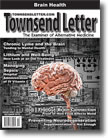Page 1, 2
KH: I am thrilled about your work and have been waiting a long time to see larger doses of ascorbate used intravenously for acute illness, but you are probably well aware while these are very large doses for conventional medical care, these are small doses of intravenous vitamin C for those practitioners who used it regularly. AA at 30 to 100 grams IV are "not uncommon" intravenous doses in integrative medicine practices? Can you comment, please?
AAF: We are well aware of the literature and the dosages of AA that have been reported by physicians engaged in various studies (i.e., cancer). The AA dosage protocol we administered to septic patients emerged out of carefully performed scientific investigation. You can refer to the scientific papers we have published using the dosage we arrived at.2-7
KH: What was the solution with vitamin C? D5W, sterile water? Were there any added nutrients as well to the ascorbate solution?
AAF: AA (vitamin C) was prepared by VCU Medical Center's Investigational Pharmacy in 50 ml aliquots. AA was mixed with dextrose 5% and water. Once the AA solution was prepared, the aliquots to be administered were kept at 4 ºC in the dark. The 50 ml aliquots had a light protected hood placed over the bag. When AA was to be infused, the hooded AA aliquot was taken from the ICU refrigerator and infused into the patient in light-protected tubing over 30 minutes. All these measures were taken to prevent AA from spontaneously oxidizing, which it will do if these measures are not addressed. No nutrients were added to the AA solution.
KH: How can the public or health professionals use this information?
AAF: We feel that AA infusion into critically ill patients is a totally overlooked form of therapy. AA to treat bacterial and fungal sepsis is a form of therapy which has been "hiding in plain sight." We are hopeful that AA infusion to treat severe sepsis will emerge into the standard of care for this patient population. We are currently conducting an NIH-sponsored double-blind, placebo-controlled trial examining specifically the effectiveness of AA to treat sepsis-induced acute respiratory distress syndrome (ARDS). This trial is a phase II trial in which Virginia Commonwealth University School of Medicine Pulmonary Disease and Critical Care Medicine Division is the lead center. Participating centers are Critical Care Medicine at Emory University, Critical Care Medicine at the Cleveland Clinic, and Critical Care Medicine at the Medical College of Wisconsin. The results of this trial will be published within the next two years.
KH: Do you have any further comments on this very interesting subject?
AAF: We currently are expanding our research with AA infusions further into human subjects. We have phase I trials using AA in patients post open heart surgery, patients with post closed head injury, and patients post cardiac arrest. We are at work designing a trial to examine AA infusion in patients post bone marrow transplant. All these various patient populations have a high incidence of organ injury.
KH: Can't wait to see the research. Send the published results on any AA IV infusion in hospital care as soon as published and I would love to interview you or your colleagues on that topic. You are doing a great service putting this safe, cheap, and simple therapy to scientific rigor, which, in my opinion, would/will save thousands of lives and millions, if not billions, of dollars in health-care costs.
AAF: You are right about that. The US Food and Drug Administration 2½ years ago removed a product called activated protein C from the market. Activated protein C was used to treat patients with severe sepsis, the identical patients we used AA to treat. Virginia Commonwealth University Health System's charge for a 96-hour infusion of activated protein C was greater than $30,000. Activated protein C, besides being expensive, was associated with a high incidence of adverse events. We calculated the cost of AA we used in the Phase I Sepsis Trial. We could treat the identical patients for less than $1000. So you are right. AA as a therapy for sepsis is safe and inexpensive compared with other drug costs in the ICU environment.
Alpha A. Fowler, III, MD
Division of Pulmonary Disease and Critical Care Medicine
Department of Internal Medicine, School of Medicine
Virginia Commonwealth University
PO Box 980050, Richmond, Virginia 23298-0050
804-828-9071; fax 804-828-2578
afowler@mcvh-vcu.edu
Notes
1. Fowler AA, Syed AA, Knowlson S, et al. Phase I safety trial of intravenous ascorbic acid in patients with severe sepsis. J Transl Med. 2014;12:32.
2. Fisher BJ, Kraskauskas D, Martin EJ, et al. Mechanisms of attenuation of abdominal sepsis induced acute lung injury by ascorbic acid. Am J Physiol Lung Cell Mol Physiol. 2012 Jul 1;303(1):L20–L32
3. Fisher BJ, Seropian IM, Kraskauskas D, et al. Ascorbic acid attenuates lipopolysaccharide-induced acute lung injury. Crit Care Med. 2011 Jun;39(6):1454–1460.
4. Fisher BJ, Kraskauskas D, Martin EJ, et al. Attenuation of sepsis-induced organ injury in mice by vitamin C. JPEN J Parenter Enteral Nutr. 2014 Sep;38(7):825–839.
5. Fowler AA 3rd, Syed AA, Knowlson S, et al.; Medical Respiratory Intensive Care Unit Nursing, Fisher BJ, Natarajan R. Phase I safety trial of intravenous ascorbic acid in patients with severe sepsis. J Transl Med. 2014 Jan 31;12:32.
6. Mohammed BM, Fisher BJ, Huynh QK, et al. Resolution of sterile inflammation: role for vitamin C. Mediators Inflamm. 2014;2014:173403.
7. Mohammed BM, Fisher BJ, Kraskauskas D, et al. Vitamin C: a novel regulator of neutrophil extracellular trap formation. Nutrients. 2013 Aug 9;5(8):3131–3151.
Compliments of Tishcon Corp., makers of Q-Gel.
For more expert interviews and the Clinical Pearls database, go to Vitasearch.com.
You can get Kirk Hamilton's "Healthy Living Tips" at HealthyLivingforBusyPeople.com.
Page 1, 2
|
![]()
![]()
![]()




